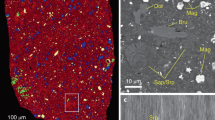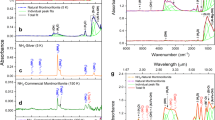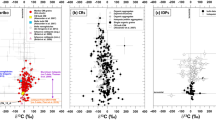Abstract
Studies of the dwarf planet (1) Ceres using ground-based and orbiting telescopes have concluded that its closest meteoritic analogues are the volatile-rich CI and CM carbonaceous chondrites1,2. Water in clay minerals3, ammoniated phyllosilicates4, or a mixture of Mg(OH)2 (brucite), Mg2CO3 and iron-rich serpentine5,6 have all been proposed to exist on the surface. In particular, brucite has been suggested from analysis of the mid-infrared spectrum of Ceres6. But the lack of spectral data across telluric absorption bands in the wavelength region 2.5 to 2.9 micrometres—where the OH stretching vibration and the H2O bending overtone are found—has precluded definitive identifications. In addition, water vapour around Ceres has recently been reported7, possibly originating from localized sources. Here we report spectra of Ceres from 0.4 to 5 micrometres acquired at distances from ~82,000 to 4,300 kilometres from the surface. Our measurements indicate widespread ammoniated phyllosilicates across the surface, but no detectable water ice. Ammonia, accreted either as organic matter or as ice, may have reacted with phyllosilicates on Ceres during differentiation. This suggests that material from the outer Solar System was incorporated into Ceres, either during its formation at great heliocentric distance or by incorporation of material transported into the main asteroid belt.
This is a preview of subscription content, access via your institution
Access options
Subscribe to this journal
Receive 51 print issues and online access
$199.00 per year
only $3.90 per issue
Buy this article
- Purchase on Springer Link
- Instant access to full article PDF
Prices may be subject to local taxes which are calculated during checkout




Similar content being viewed by others
References
Chapman, C. R. & Salisbury, J. W. Comparisons of meteorite and asteroid spectral reflectivities. Icarus 19, 507–522 (1973)
McCord, T. & Gaffey, M. J. Asteroids: surface composition from reflectance spectroscopy. Science 186, 352–355 (1974)
Lebofsky, L., Feierberg, M., Tokunaga, A., Larson, H. & Johnson, J. The 1.7–4.2 μm spectrum of asteroid 1 Ceres: evidence for structural water in clay minerals. Icarus 48, 453–459 (1981)
King, T., Clark, R., Calvin, W., Sherman, D. & Brown, R. Evidence for ammonium-bearing minerals on Ceres. Science 255, 1551–1553 (1992)
Rivkin, A. S., Volquardsen, E. L. & Clark, B. E. The surface composition of Ceres: discovery of carbonates and iron-rich clays. Icarus 185, 563–567 (2006)
Milliken, R. E. & Rivkin, A. S. Brucite and carbonate assemblages from altered olivine-rich materials on Ceres. Nature Geosci. 2, 258–261 (2009)
Küppers, M. et al. Localized sources of water vapour on the dwarf planet (1) Ceres. Nature 505, 525–527 (2014)
De Sanctis, M. C. et al. The VIR spectrometer. Space Sci. Rev. 163, 329–369 (2011)
Russell, C. T. & Raymond, C. A. The Dawn Mission to Vesta and Ceres. Space Sci. Rev. 163, 3–23 (2011)
Nathues, A. et al. Sublimation in bright spots on (1) Ceres. Nature http://dx.doi.org/10.1038/nature15754 (this issue)
Helfenstein, P. & Veverka, J. in Asteroids II (eds Binzel, R. P., Gehrels, T. & Matthews, M. S. ) 557–593 (Univ. Arizona Press, 1989)
Li, J.-Y. et al. Photometric analysis of 1 Ceres and surface mapping from HST observations. Icarus 182, 143–160 (2006)
Takir, D. et al. Nature and degree of aqueous alteration in CM and CI carbonaceous chondrites. Meteorit. Planet. Sci. 48, 1618–1637 (2013)
Takir, D. & Emery, J. P. Outer main belt asteroids: identification and distribution of four 3-μm spectral groups. Icarus 219, 641–654 (2012)
Beck, P., Schmitt, B., Cloutis, E. A. & Vernazza, P. Low-temperature reflectance spectra of brucite and the primitive surface of 1-Ceres? Icarus 257, 471–476 (2015)
Bishop, J. L. et al. Reflectance and emission spectroscopy study of four groups of phyllosilicates: smectites, kaolinite-serpentines, chlorites and micas. Clay Miner. 43, 35–54 (2008)
Hapke, B. Theory of Reflectance and Emittance Spectroscopy (Cambridge Univ. Press, 2012)
Howard, K. T., Alexander, C. M. O’D., Schrader, D. L. & Dyl, K. A. Classification of hydrous meteorites (CR, CM and C2 ungrouped) by phyllosilicate fraction: PSD-XRD modal mineralogy and planetesimal environments. Geochim. Cosmochim. Acta 149, 206–222 (2015)
Bishop, J. L., Banin, A., Mancinelli, R. L. & Klovstad, M. L. Detection of soluble and fixed NH4+ in clay minerals by DTA and IR reflectance spectroscopy: a potential tool for planetary surface exploration. Planet. Space Sci. 50, 11–19 (2002)
Pizzarello, S. & Williams, L. B. Ammonia in the early Solar System: an account from carbonaceous meteorites. Astrophys. J. 749, 161–167 (2012)
Borden, D. & Giese, R. F. Baseline studies of the Clay Minerals Society source clays: cation exchange capacity measurements by the ammonia-electrode method. Clays Clay Miner. 49, 444–445 (2001)
Martin, R. G. & Livio, M. On the evolution of the snow line in protoplanetary discs. Mon. Not. R. Astron. Soc. Lett. 425, L6–L9 (2012)
Lodders, K. Solar System abundances and condensation temperatures of the elements. Astrophys. J. 591, 1220–1247 (2003)
Bitsch, B., Johansen, A., Lambrechts, M. & Morbidelli, A. The structure of protoplanetary discs around evolving young stars. Astron. Astrophys. 575, A28 (2015)
Johansen, A., Mac Low, M.-M., Lacerda, P. & Bizzarro, M. Growth of asteroids, planetary embryos, and Kuiper belt objects by chondrule accretion. Sci. Adv. 1, 1500109 (2015)
McKinnon, W. B. Where did Ceres accrete? In Proc. Conf. Asteroids, Comets, Meteors 2012 abstr. 6475, http://www.lpi.usra.edu/meetings/acm2012/pdf/6475.pdf (2012)
DeMeo, F. E. et al. Spectral variability of Charon’s 2.21-μm feature. Icarus 246, 213–219 (2015)
Barucci, M. A. et al. Surface composition and temperature of the TNO Orcus. Astron. Astrophys. 479, L13–L16 (2008)
Walsh, K. J., Morbidelli, A., Raymond, S. N., O’Brien, D. P. & Mandell, A. M. A low mass for Mars from Jupiter’s early gas-driven migration. Nature 475, 206–209 (2011)
Levison, H. et al. Contamination of the asteroid belt by primordial trans-Neptunian objects. Nature 460, 364–366 (2009)
Carli, C., Ciarniello, M., Capaccioni, F., Serventi, G. & Sgavetti, M. Spectral variability of plagioclase-mafic mixtures (2): investigation of the optical constant and retrieved mineral abundance dependence on particle size distribution. Icarus 235, 207–219 (2014)
Raponi, A. Spectrophotometric Analysis of Cometary Nuclei from in situ Observations. PhD thesis, TorVergata Univ. (2015)
Hiroi, T., Zolensky, M. E. & Pieters, C. M. Characterization of unusual CI/CM/CR meteorites from reflectance spectroscopy. Lunar Planet. Sci. Conf. 28, 577 (1997)
Hiroi, T., Pieters, C. M., Zolensky, M. E. & Prinz, M. Reflectance spectra (UV-3 μm) of heated Ivuna (CI) meteorite and newly identified thermally metamorphosed CM chondrites. Lunar Planet. Sci. 27, 551–552 (1996)
Hiroi, T. et al. Thermal metamorphism of the C, G, B, and F asteroids seen from 0.7 μm, 3 μm, and UV absorption strengths in comparison with carbonaceous chondrites. Meteorit. Planet. Sci. 31, 321–327 (1996)
Bishop, J. L. et al. Coordinated spectral and XRD analyses of magnesite-nontronite-forsterite mixtures and implications for carbonates on Mars. J. Geophys. Res. Planets 118, 635–650 (2013)
Cloutis, E. et al. Spectral reflectance properties of carbonates from terrestrial analogue environments: implications for Mars. Planet. Space Sci. 58, 522–537 (2010)
Bishop, J. L. et al. Detection of soluble and fixed NH4+ in clay minerals by DTA and IR reflectance spectroscopy: a potential tool for planetary surface exploration. Planet. Space Sci. 50, 11–19 (2002)
Zubko, V. G. et al. Optical constants of cosmic carbon analogue grains — I. Simulation of clustering by a modified continuous distribution of ellipsoids. Mon. Not. R. Astron. Soc. 282, 1321–1329 (1996)
Mastrapa, R. M. et al. Optical constants of amorphous and crystalline H2O-ice in the near infrared from 1.1 to 2.6 μm. Icarus 197, 307–320 (2008)
Mastrapa, R. M. et al. Optical constants of amorphous and crystalline H2O-ice: 2.5–22 μm (4000–455 cm-1) optical constants of H2O-ice. Astrophys. J. 701, 1347–1356 (2009)
Clark, R. N. et al. The surface composition of Iapetus: mapping results from Cassini VIMS. Icarus 218, 831–860 (2012)
Warren, S. G. Optical constants of ice from the ultraviolet to the microwave. Appl. Opt. 23, 1206–1225 (1984)
Cloutis, E. et al. Spectral reflectance properties of carbonaceous chondrites: 1. CI chondrites. Icarus 212, 180–209 (2011)
Hiroi, T. K. & Zolensky, M. E. UV-Vis-NIR absorption features of heated phyllosilicates as remote-sensing clues of thermal histories of primitive asteroids. Antarct. Meteorite Res. 12, 108–116 (1999)
Acknowledgements
We thank the following institutions and agencies, which supported this work: the Italian Space Agency (ASI), the National Aeronautic and Space Administration (NASA, USA) and the Deutsches Zentrum für Luft- und Raumfahrt (DLR, Germany). The VIR was funded and coordinated by the Italian Space Agency and built by SELEX ES, with the scientific leadership of the Institute for Space Astrophysics and Planetology, Italian National Institute for Astrophysics, Italy, and is operated by the Institute for Space Astrophysics and Planetology, Rome, Italy. A portion of this work was carried out at the Jet Propulsion Laboratory, California Institute of Technology, under contract to NASA. We thank J. L. Bishop and D. Takir for reviews, and D. Takir for providing spectra of carbonaceous chondrites plotted in Fig. 2.
Author information
Authors and Affiliations
Contributions
M.C.D.S., A.R., E.A. and G.C. performed data analysis and calibration. M.C. provided optical constants from reflectance spectra. F.T. provided the surface temperatures. M.C.D.S., S.M., H.Y.M., T.B.M. and C.M.P. contributed to the interpretation of the data. All authors contributed to the discussion of the results and to writing the paper.
Corresponding author
Ethics declarations
Competing interests
The authors declare no competing financial interests.
Extended data figures and tables
Extended Data Figure 1 End-member spectra used for spectral fit modelling.
a, Spectra of minerals showing a prominent absorption at 2.7 μm. b, Spectra of minerals showing a prominent 3.06–3.1 μm band. c, Spectra of carbonates; and d, spectra of dark components and carbonaceous chondrites used in the modelling. All panels show the Ceres spectrum (black) for comparison.
Extended Data Figure 2 Spectral fit of the spectrum of Ceres including water.
a, b, Red curves, results of the spectral fitting model using water ice and amorphous carbon (a) or water ice and magnetite (b). Ceres’ spectrum is in black. The error bars are calculated taking into account a mean absolute deviation of the calibration uncertainties along the 256 samples.
Extended Data Figure 3 Spectral fit of the spectrum of Ceres including carbonaceous chondrites.
a–d, Results of the spectral fitting model (red curves) using water ice and Ivuna CI chondrite (a; heated at 500 °C); water ice and MAC 87300 CM chondrite (b); water ice and Murchison CM chondrite (c; heated at 500 °C); and water ice, Ivuna CI chondrite (heated at 500 °C) and brucite (d). Ceres’ spectrum is in black. Error bars and vertical grey bars as in Extended Data Fig. 2.
Extended Data Figure 4 Spectral fit of the spectrum of Ceres including cronstedtite, tochilinite and brucite.
a–d, Results of the spectral fitting model (red curves) using tochilinite, cronstedtite, dolomite and magnetite (a); antigorite, cronstedtite, dolomite and magnetite (b); tochilinite, brucite, dolomite and magnetite (c); and antigorite, brucite, dolomite and magnetite (d). Ceres’s spectrum is in black. Error bars and vertical grey bars as in Extended Data Fig. 2.
Extended Data Figure 5 Spectral fit of the spectrum of Ceres including different carbonates.
a–d, Results of the spectral fitting model (red curves) using NH4-annite, antigorite, magnetite and siderite (a); NH4-annite, antigorite, magnetite and calcite (b); NH4-annite, antigorite, magnetite and magnesite (c); and NH4-annite, antigorite, magnetite and dolomite (d). Ceres’ spectrum is in black. Error bars and vertical grey bars as in Extended Data Fig. 2.
Rights and permissions
About this article
Cite this article
De Sanctis, M., Ammannito, E., Raponi, A. et al. Ammoniated phyllosilicates with a likely outer Solar System origin on (1) Ceres. Nature 528, 241–244 (2015). https://doi.org/10.1038/nature16172
Received:
Accepted:
Published:
Issue Date:
DOI: https://doi.org/10.1038/nature16172
This article is cited by
-
Nitrogen K-edge X-ray adsorption near-edge structure spectroscopy of chemically adsorbed ammonia gas on clay minerals and the 15N/14N-nitrogen isotopic fractionation
Analytical Sciences (2024)
-
Surface Compositions of Trojan Asteroids
Space Science Reviews (2024)
-
Late accretion of Ceres-like asteroids and their implantation into the outer main belt
Nature Astronomy (2023)
-
Salts and organics on Ganymede’s surface observed by the JIRAM spectrometer onboard Juno
Nature Astronomy (2023)
-
Influx of nitrogen-rich material from the outer Solar System indicated by iron nitride in Ryugu samples
Nature Astronomy (2023)
Comments
By submitting a comment you agree to abide by our Terms and Community Guidelines. If you find something abusive or that does not comply with our terms or guidelines please flag it as inappropriate.



